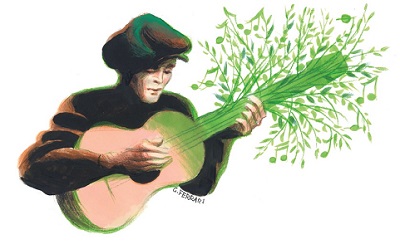This land is your land
Publish date 19-04-2022
 Air, water and… yes, even the soil! They are all indispensable. We often don't think about it because we don't know it well enough. For us it is a surface that supports us but it is a question of looking also at the subsoil, where irreplaceable functions take place: from the soil comes the food for all living forms. It is the fertile ground that almost all of our food depends on, 95%! The fertile soil is only 32% of the land. It is not a renewable resource so it is at risk: it takes 500 years to generate 2.5 cm of fertile soil. The organic part (humus) is the "treasure" and ranges from 2 mm to 20/28 cm. It represents 1% to 6/10% of the land. Who does all this work to regenerate the soil? A gigantic chemical, physical, biological laboratory that breaks down molecules to make nutrients such as nitrogen, phosphorus, sulfur and carbon available.
Air, water and… yes, even the soil! They are all indispensable. We often don't think about it because we don't know it well enough. For us it is a surface that supports us but it is a question of looking also at the subsoil, where irreplaceable functions take place: from the soil comes the food for all living forms. It is the fertile ground that almost all of our food depends on, 95%! The fertile soil is only 32% of the land. It is not a renewable resource so it is at risk: it takes 500 years to generate 2.5 cm of fertile soil. The organic part (humus) is the "treasure" and ranges from 2 mm to 20/28 cm. It represents 1% to 6/10% of the land. Who does all this work to regenerate the soil? A gigantic chemical, physical, biological laboratory that breaks down molecules to make nutrients such as nitrogen, phosphorus, sulfur and carbon available.
The soil is the origin of everything else and offers essential services to all living beings (including humans). In summary, in addition to food: it supports living beings and also human infrastructures; contains the raw materials for construction; it is the basis for agriculture and forestry activities; the seat of the production of almost all foods; retains, purifies and stores water; create the landscapes; hosts playful activities. The soil
(not damaged!) helps to combat climate change, because it is a warehouse of carbon and CO2 (carbon dioxide / carbon dioxide), contained in the organic substance which is composed of 58% carbon.
The storage of carbon in the soil is about 3 times higher than that of the vegetation of a forest / wood; about 4/5 times of the CO2 present in the atmosphere. It is therefore the largest carbon deposit on land. In addition to natural threat factors such as erosion, landslides, landslides, compaction, salinization, there are threats from human activities: the construction of buildings and infrastructures that waterproof the land causing it to die; soil compaction by mechanical means; the reduction of waterways and diversions that create floods and destroy the functioning of the soil; excessive intensive and monocultural agriculture; pollutions that damage the soil "laboratory". The final stage of some of this damage is desertification.
What can we do as individual behaviors and as actions of governments and all subjects from the local community, to the whole country, to Europe, to the world; extend soil health monitoring; modify and spread agricultural practices in favor of sustainable ones in agriculture; plant trees and care for them; build a minimum of new buildings; in the city improve the presence of vegetation aimed at the microclimate. And then a regenerative agricultural practice.
Biogas and compost can be obtained from organic waste. And then… there is much more to do!
Last but not least, inform, raise awareness, involve people, associations, institutions, businesses, in objectives and projects to safeguard the territory in the micro (near us) and in the macro (in every part of the world). < br />
Carlo Degiacomi
NP January 2022







